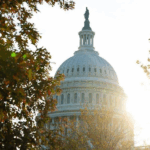
With a bipartisan Senate vote to approve funding the federal government now in the books, the longest shutdown in US history appears to be drawing to a close.
Furloughed federal employees will return to work. They, and those who were deemed too “essential” to send home, will start receiving pay cheques – including back pay – once again.
Air travel in the US will return to a somewhat tolerable normal. Food aid for low-income Americans will resume. National parks will reopen.
The ordeals, great and small, that the shutdown had triggered for many Americans will end.
The political consequences of this record standoff, however, will linger even as the government returns to work.
Here are three major takeaways now that an exit ramp has come into view.
Democrats divided
In the end, the Democrats blinked. Or, at least, just enough centrists, soon-to-be retirees and at-risk politicians in the Senate to give Republicans the support needed to reopen the government.
For those who voted along with Republicans, the pain from the shutdown had become too severe. For others in the party, however, it was the cost of backing down that was unbearable.
“I cannot support a deal that still leaves millions of Americans wondering how they are going to pay for their health care or whether they will be able to afford to get sick,” Senator Mark Warner of Virginia said in a statement.
The way this shutdown is ending is sure to reopen old wounds between the party’s activist and left-wing base and its institutionalist, centrist establishment. The divides within the party, which last week was celebrating electoral victories in Virginia and New Jersey, are sure to sharpen.
Democrats have been outraged over Republican-backed cuts to government programmes and reductions in the federal workforce. They’ve accused Donald Trump of pushing – and breaking – the boundaries of presidential power. They’ve warned that the nation is veering toward authoritarianism.
The shutdown, for many on the left, was a chance for Democrats to draw a line in the sand. And now that it appears the government will reopen with no fundamental changes or new limits on Trump, many on the left will feel this was a wasted opportunity. And they will be angry.
Trump’s hard line pays off
Over the course of the 40-day shutdown, Trump took two international trips – to the Middle East and East Asia. He golfed. He made multiple visits to his personal properties, including one to hold a lavish “Great Gatsby” style fundraising party at his Mar-a-Lago estate.
What he didn’t do was push his party to compromise with Democrats. And in the end, that hard line paid off.
The White House agreed to roll back the “grim reaper” workforce cuts it had ordered during the shutdown.
Senate Republicans promised a vote on government health-insurance subsidies. But a vote isn’t a guarantee, and there’s little that Trump and his team gave up on Day 40 that they wouldn’t have agreed to on day one. The Senate Democrats who finally broke with their party to reopen the government said they had little hope of headway with Republicans.
“It wasn’t working,” said Angus King – an independent who sides with the Democrats – of the party’s shutdown strategy. Jeanne Shaheen, a Democrat from New Hampshire, said that Sunday night’s agreement was “the only deal on the table”.
“Waiting any longer will only prolong the pain Americans are feeling because of the shutdown,” she added. There’s no telling what was going in inside the heads of Trump and the Republican leadership team. At times, Trump even seemed to vacillate – broaching the prospect of replacing health-insurance subsidies with direct payments to Americans or doing away with the parliamentary filibuster that gave Democrats their power in the Senate.
But Republicans ultimately stuck together and did a good job convincing just enough Democrats that they weren’t going to budge.
Shutdown fights to come
This record shutdown may be close to ending, but the political dynamics that led to the standoff are still very much present.
The compromise legislation only funds most government operations until the end of January – just long enough to get the nation through the holiday season and a few weeks beyond. After that, Congress may be right back where they were when government funding ran out at the end of September.
Democrats may have backed down this time, but they didn’t face any real political consequences for blocking the Republican funding bill for more than a month. In fact, Trump’s poll numbers dropped during the shutdown and Democrats had an impressive showing in last week’s off-year state elections.
With some on the left howling that their party didn’t get enough out of this shutdown – and only a handful of party rank in file in Congress supporting this compromise – there may be plenty of motivation for further shutdown brinksmanship as next year’s midterm elections loom. And with low-income food aid now secure until October, one particularly sensitive pain point for Democrats has been taken off the table.
It had been almost five years since the last government shutdown, during Trump’s first presidential term. Chances are the next one will come much sooner than that.